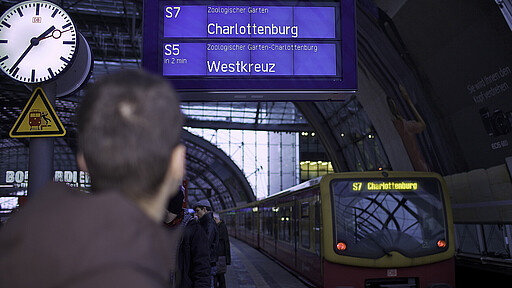Service and Safety Through State-of-the-Art Technology
With our DB partners, DB InfraGo - Tracks division (Geschäftsbereich Fahrweg), and DB InfraGo - Stations division (Geschäftsbereich Personenbahnhöfe), we are constantly working to modernize the S-Bahn's information and traffic technology. Find out what the meaning behind the high-tech abbreviations RIS-S, ZAT FM, and ZBS reveal.
RIS-S: the centrepiece of Our Passenger Information

The Berlin S-Bahn keeps passengers up to date with the Passenger Information System (RIS-S); a real-time data system displaying exact forecasts of departure times and information on train delays on station platforms. This service is also available on the Internet.
LCD Displays at the Stations
The LCD displays on the station platforms also indicate how many car units the arriving train has and where it will stop at the platform. The main stops are also displayed, and if necessary, information about delays, cancellations, or upcoming construction work is displayed in the ticker line.
Fully Automatic PA Technology
A fully automatic "Voice over IP" sound system projects voice announcements, loud and clear, throughout the S-Bahn network. The route number, destination stations and connecting transit are announced on tact while delays, cancellations, closed doors, or track changes are announced when necessary. General announcements regarding smoking bans and unattended luggage are also played regularly.
Manual Control of Indicators and Loudspeakers is Possible
In the event of an emergency, it is possible to manually operate the entire passenger information system (display boards and loudspeakers) at certain stations to provide passengers important information.
Partner Cooperation
The technology used at the stations to provide comprehensive passenger information is owned by DB InfraGo - Stations division (Geschäftsbereich Personenbahnhöfe). The high-performance transmission network for all data communication is provided by DB InfraGo - Tracks division (Geschäftsbereich Fahrweg).
Train Dispatching Through the Conductor
On the S-Bahn stations, train conducting is mainly carried out by the engine driver. In about half of all stations, the conductor makes use of mirrors mounted on the platform, such as those used on the subway. This type of train clearance is only possible at clearly visible stations. There are few stations where the conductor must step out of the cab.
Use of ZAT FM
Stations where the conductor can not survey the entire edge of the platform require the use of ZAT FM. We use this train-operation technology at 84 stations. The cameras installed on the platform transfer images to a monitor, where the conductor is able to: observe the passengers getting in and out of the train, close the doors and check that there are no objects or people trapped in the doors. At the same time, the camera images are transmitted to the central operating station so that the supervisor on duty can support the conductor if needed.
ZBS: The Installation of a New Train Control System
Since October 2011, DB InfraGo - Tracks division (Geschäftsbereich Fahrweg) has been gradually upgrading the route network with a new train control system (ZBS) for the Berlin S-Bahn, which will replace the previous safety technology, a mechanical train control system. The conversion was already completed in January 2021 on the (Stadtbahn) subnetwork. Completion for the North-South (Nord-Süd) subnetwork is planned by the end of 2023 and for the Ring subnetwork by the end of 2025.
The Versatile Functions of ZBS
Compared to the previous technology, the new system also monitors compliance with the permitted speed of trains, with respect to railway signaling. For this purpose, the tracks are equipped with balises, electronic transponders which serve as "beacons" providing the exact location of a train. A computer system on the train evaluates the data, monitors the speed, controls the decreasing speed when thebr train approaches stop signals, and releases the emergency brake if necessary. Electronic displays and announcements in the cab of the train assist the conductor at work.
DB InfraGo - Tracks division: Signal operation by mouse click

In order to operate the S-Bahn safely through the city, it takes more than trains and tracks. DB InfraGo - Tracks division provides the S-Bahn Berlin with the necessary infrastructure. The average S-Bahn work day at the operations center always entails signal operation.
